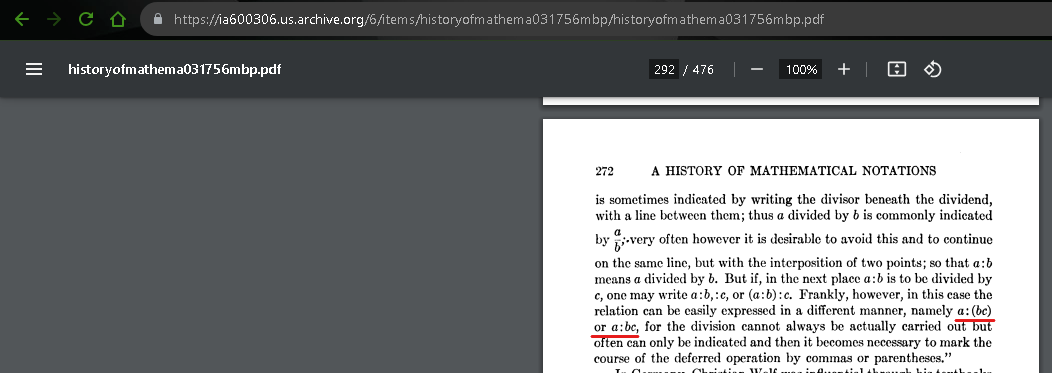I wrote a (very long) blog post about those viral math problems and am looking for feedback, especially from people who are not convinced that the problem is ambiguous.
It’s about a 30min read so thank you in advance if you really take the time to read it, but I think it’s worth it if you joined such discussions in the past, but I’m probably biased because I wrote it :)
If you are so sure that you are right and already “know it all”, why bother and even read this? There is no comment section to argue.
I beg to differ. You utter fool! You created a comment section yourself on lemmy and you are clearly wrong about everything!
You take the mean of 1 and 9 which is 4.5!
/j
Right, because 5 rounds down to 4.5
@Prunebutt meant 4.5! and not 4.5. Because it’s not an integer we have to use the gamma function, the extension of the factorial function to get the actual mean between 1 and 9 => 4.5! = 52.3428 which looks about right 🤣
🤣 I wasn’t even sure if I should post it on lemmy. I mainly wrote it so I can post it under other peoples posts that actually are intended to artificially create drama to hopefully show enough people what the actual problems are with those puzzles.
But I probably am a fool and this is not going anywhere because most people won’t read a 30min article about those math problems :-)
I did (skimmed it, at least) and I liked it. 🙃
Actually the correct answer is clearly 0.2609 if you follow the order of operations correctly:
6/2(1+2)
= 6/23
= 0.26🤣 I’m not sure if you read the post but I also wrote about that (the paragraph right before “What about the real world?”)
I did read the post (well done btw), but I guess I must have missed that. And here I thought I was a comedic genius
I would do the mighty parentheses first, and then the 2 that dares to touch the mighty parentheses, finally getting to the run-of-the-mill division. Hence the answer is One.
I am so glad that nothing I do in life will ever cause this problem to matter to me.
The way I was taught in school, the answer is clearly 1, but I did read the blog post and I understand why that’s actually ambiguous.
Fortunately, I don’t have to care, so will sleep well knowing the answer is 1, and that I’m as correct as anyone else. :-p
why that’s actually ambiguous.
It isn’t actually ambiguous. You have remembered what you were taught in school, unlike the author of the blog post, who manages to write the whole thing without ever once checking a Maths textbook (which would reveal the only correct answer to be 1).
Honestly, I do disagree that the question is ambiguous. The lack of parenthetical separation is itself a choice that informs order of operations. If the answer was meant to be 9, then the 6/2 would be isolated in parenthesis.
Nope it’s bedmas since everything is brackets
I guess if you wrote it out with a different annotation it would be
6
-‐--------‐--------------
2(1+2)
=
6
-‐--------‐--------------
2×3
=
6
–‐--------‐--------------
6
=1
I hate the stupid things though
Markdown fucked your comment. Use escape symbols.
Escape symbols?
Never mind, here’s another better way to do this:
6⁄2(1+2) ⇒ 6⁄2*3 ⇒ 6⁄6 ⇒ 1
Works on the web page, but looks weird on some mobile app. Markdown is a fucking mess. Some implementation has MathJax support, some have special syntaxes.
6⁄2(1+2) ⇒ 6⁄2*3 ⇒ 6⁄6 ⇒ 1
You’re more patient than me to go to that trouble! 😂 But yeah, looks good. Just one technicality (and relates to how many people arrive at the wrong answer), the 2x3 should be in brackets. Yes if you had a proper fraction bar it wouldn’t matter, but that’s what’s missing with inline writing, and is compensated for with brackets (and brackets can’t be removed unless there’s only 1 term inside). In your original comment, it does indeed look like 6/(2x3), but, to illustrate the issue with what you wrote, as soon as I quoted it, it now looks like (6/2)x3 in my comment.
I’ve seen a calculator interpret 1 ÷ 2π as ½π which was kinda funny
An e-calculator I’m guessing? (either that or Texas Instruments) Desmos USED TO interpret that correctly, but then they made a change with automatically turning division into fractions and broke it (because if you’ve specified division then it’s not a fraction) dotnet.social/@SmartmanApps/111164851485070719
I believe it was a app , yes
All calculators that are listed in the article as following weak juxtaposition would interpreted it that way.
And they’re all wrong dotnet.social/@SmartmanApps/111164851485070719
The ambiguous ones at least have some discussion around it. The ones I’ve seen thenxouple times I had the misfortune of seeing them on Facebook were just straight up basic order of operations questions. They weren’t ambiguous, they were about a 4th grade math level, and all thenpeople from my high-school that complain that school never taught them anything were completely failing to get it.
I’m talking like 4+1x2 and a bunch of people were saying it was 10.
What if the real answer is the friends we made along the way?
That’d be good, but what I’ve found so far here is a whole bunch of people who don’t like being told the actual facts of the matter! 😂
Hi! Nice blog post. Since you asked for feedback I’ll point out the one thing I didn’t really understand. You explain the difference between the calculators by showing excerpts from the manuals and you highlight that in the first manual, implicit multiplication is prioritised. But the text you underlined only refers to implicit multiplication involving special expressions(?) like pi, e, sqrt or log, and nothing about “regular” implicit multiplication like 2(1+3). So while your photos of the calculator results are great proof that the two models use a different order of operations, to me the manuals were a bit confusing since they did not actually seem to prove your point for the example math problems you are discussing. Or maybe I missed something?
only refers to implicit multiplication involving special expressions(?) like pi, e, sqrt or log, and nothing about “regular” implicit multiplication like 2(1+3)
That was a very astute observation you made there! The fact is, for the very reason you stated, there is in fact no such thing as “implicit multiplication” - it is a term which has been made up by people who have forgotten Terms (the first thing you mentioned) and The Distributive Law (the second thing you mentioned). As you’ve noted., these are 2 different rules, and lumping them together as one brings exactly the disastrous results you might expect from lumping different 2 rules together as one…
See here for explanation of all the various rules, including textbook references and proofs.
@wischi “Funny enough all the examples that N.J. Lennes list in his letter use implicit multiplications and thus his rule could be replaced by the strong juxtaposition”.
Weird they didn’t need two made-up terms to get it right 100 years ago.
What the heck are you all fighting about? It’s BODMAS.
They’re arguing about whether Distribution is Multiplication or not. Spoiler alert: it isn’t, it’s Brackets.
PEDMAS sounds like one of those cheap, off-brand protein powders that are abused by body-builders.
So what does BODMAS sound like to the other side?
samdob
I’d would be great if you find the time to read the post and let me know afterwards what you think. It actually looks trivial as a problem but the situation really isn’t, that’s why the article is so long.
It actually looks trivial as a problem
Because it actually is.
that’s why the article is so long
The article was really long because there were so many stawmen in it. Had you checked a Maths textbook or asked a Maths teacher it could’ve been really short, but you never did either.
I was being facetious. I will try to find the time to read the post, but I know already that the problem isn’t trivial. It involves, above all else, human comprehension, which is a very iffy thing, to say the least.
I think this speaks to why I have a total of 5 years of college and no degree.
Starting at about 7th grade, math class is taught to every single American school child as if they’re going to grow up to become mathematicians. Formal definitions, proofs, long sets of rules for how you manipulate squiggles to become other squiggles that you’re supposed to obey because that’s what the book says.
Early my 7th grade year, my teacher wrote a long string of numbers and operators on the board, something like 6 + 4 - 7 * 8 + 3 / 9. Then told us to work this problem and then say what we came up with. This divided us into two groups: Those who hadn’t learned Order of Operations on our own time who did (six plus four is ten, minus seven is three, times eight is 24, plus three is 27, divided by nine is three) Three, and who were then told we were wrong and stupid, and those who somehow had, who did (seven times eight is 56, three divided by nine is some tiny fraction…) got a very different number, and were told they were right. Terrible method of teaching, because it alienates the students who need to do the learning right off the bat. And this basically set the tone until I dropped out of college for the second time.
Yes, unfortunately there are some bad teachers around. I vividly remember the one I had in Year 10, who literally didn’t care if we did well or not. I got sick for an extended period that year, and got a tutor - my Maths improved when I had the tutor (someone who actually helped me to learn the material)!
While I agree the problem as written is ambiguous and should be written with explicit operators, I have 1 argument to make. In pretty much every other field if we have a question the answer pretty much always ends up being something along the lines of “well the experts do this” or “this professor at this prestigious university says this”, or “the scientific community says”. The fact that this article even states that academic circles and “scientific” calculators use strong juxtaposition, while basic education and basic calculators use weak juxtaposition is interesting. Why do we treat math differently than pretty much every other field? Shouldn’t strong juxtaposition be the precedent and the norm then just how the scientific community sets precedents for literally every other field? We should start saying weak juxtaposition is wrong and just settle on one.
This has been my devil’s advocate argument.
FACT CHECK 2/5
The behaviour is intended and even carefully documented in the manual
…and yet still a bug (I saw at least one other person point this out to you)
A few years ago, there was a Microsoft feature intended for people in China, but people who weren’t in China were getting that behaviour. i.e. a bug. It was documented and a deliberate design choice for people in China, but if you weren’t in China then it’s a bug. Just documenting a design choice doesn’t mean bugs don’t happen. A calculator giving a wrong answer is a bug
weak juxtaposition is only used by old calculators
Based on the comments in the above video, the opposite is true - this problem first arose in '96
because they are scientific calculators.
So the person programming it is far more likely to need to check their Maths first - bingo!
TI (Texas Instruments) also has some calculators that use strong juxtaposition and some products that use weak juxtaposition
…and some that use both! i.e. some follow Terms but not The Distributive Law. As I said to begin with, these are 2 DIFFERENT rules, and you can’t just lump them together as one
evaluate 1/2X as 1/(2X)
Which is correct, as per Terms
while other products may evaluate the same expression as 1/2X from left to right
What you mean is they evaluate it as 1/2xX, since 1/2X and 1/(2X) are the same thing
it would be necessary to group 2X in parentheses
No, not necessary, since 2a=(2xa) by definition, alluded to in Cajori in 1928…

Sharp is a bit of an exception here, because all their other scientific calculators seem to
…follow all the rules of Maths, always. There’s something to be said for making sure you’re doing it right. :-)
Google uses the same priority for explicit and implicit multiplication
…and they will actually remove brackets I have put in and replace them with their own (“hi” to all the people who say you can fix any calculator by “just add more brackets” - Google doesn’t CARE what brackets you’ve added!)
Desmos and GeoGebra try to force the user into using fractions (which is a good design decision if you ask me)
It’s not, because a ÷ isn’t a fraction bar. They’re joining 2 terms into one and thus sometimes changing the answer
A lot of other tools like programming languages, spreadsheets, etc. don’t allow implicit multiplication syntax at all
It’s not that they don’t allow it, it’s that it’s not provided with the language by default in the first place! Most languages only provide you with some numbers, operators, and a few functions (like round), and it’s up to the programmer to implement the rest. Welcome to why there are so many wrong e-calculators
let you choose if you want weak or strong juxtaposition
…which is a red flag to not use that calculator!
This gives you more control about how you like the calculator to behave in these situations
I’m not sure it does. I’d have to switch on “strong juxtaposition” (the only kind there is) and see what else has been disobeyed in Maths. e.g. Google removing my brackets and adding different ones
Wolfram|Alpha only uses strong juxtaposition between named variables, but weak juxtaposition for everything else. This might seem strange and inconsistent at first but is probably the least surprising behaviour for most people
I find any exceptions to following the rules of Maths surprising! No, you can’t just make up your own rules
many textbooks, “a/bc” is intended to denote a/(bc)
a/bc=a/(bc) in every textbook
Wolfram Language, it means (a/b)×c
Welcome to “we’re gonna add brackets to what you typed in and change the answer”
a multiplication sign has been omitted
…then that means it’s not “multiplication” - it’s Terms and/or The Distributive Law. The “M” in the mnemonics refers literally to multiplication signs, nothing else
Multiplication and division have the same priority, they are “mathematically speaking” the same operation. This also applies to addition and subtraction. One is just the inverse function of the other
Yep, and The Distributive Law and Factorising are the inverse of each other
no rule about “multiplication before division” or “division before multiplication” they always have the same priority
…and Brackets is always first, so in this case it doesn’t even matter
In no way do any of the mnemonics represent any standard or norm in mathematics
Yes they do - mnemonics represent the actual order of operations rules
most children don’t become mathematicians later in life and if they do, they will learn all the other important stuff about the order of operations later
No, they won’t. Year 8 is the last time order of operations is taught, and they have been taught everything they need to know about it by then
it’s hard to pump so much knowledge into children and teenagers
…and yet have you not noticed that teenagers almost never get this wrong - only adults do
Using “PEMDAS” to argue about the order of operations in mathematics
…is a totally valid thing to do. The problem is people classifying Distribution (Brackets/Parentheses with a coefficient) as “Multiplication”, when there’s literally no multiplication sign
Math notations and conventions evolve exactly like natural languages
No they don’t. Maths is universal
A lot of it is heavily based on historical thanks and work from previous generations
It’s all based on definitions and proofs, which are immutable
There is no definitive norm, standard or convention of notations and order of operations
You can find them in any high school textbook in your country (notation varies by country, but the rules don’t)
some words only appear in half of them (like “implicit multiplication by juxtaposition”)
“implicit multiplication” doesn’t appear in any Maths textbooks
sentences like “I saw the man with the telescope”, because it’s not clear if you saw him through the telescope or saw him holding (or looking through) a telescope
Yes it is clear (as I think I saw someone already point out here)
I saw the man with the telescope - the man has the telescope
I saw the man, with the telescope - I saw the man through a telescope
I saw the man through the telescope - I saw the man through a telescope
it should also be clear why there are no arguments or proofs for any side
But there are proofs! (There you go again with the “there is no…” red flag) Order of operations proof








